-
684
Description: Arched rectangular central panel with bead edging; an inverted, cabled anchor surmounted by a crown, flanked by one initial each side; arched rectangular border with cavetto-moulded edging; top centre, face of a putto with flowing leaf arrangement descending each side.
Notes: An English pastiche of the ‘Dutch’ style of fireback, which became popular in the second half of the seventeenth century. One of a small series of firebacks with similar proportions and detail. Copies of this fireback were advertised in the Wayte & Cheverton (Edenbridge) catalogue in the early-20th century.
Copies of this fireback are known.
Inscription: C R
- Decoration tags:
- rectangular with round arch (shape)
- cavetto (edging)
- whole carved pattern
- planklines
- heraldic
- text
- objects
Manufactured: in the mid- to late-17th century in England.
Current location: in private hands, Sevenoaks, Kent, England.
- Attached to series:
- Carolean 'Dutch' series
- Miscellaneous royal firebacks
-
685
Description: Rectangular with arched rectangular shaped top joined by cavetto curves; astragal edging; plain surface for the addition of other stamps or panels.
Notes: Used for armorials by the Dukes of Dorset.
- Decoration tags:
- rectangular with canted top corners and round arch (shape)
- astragal (edging)
- whole carved pattern
Manufactured: in the early-18th century in the Weald area of England.
Current location: Knole, Sevenoaks, Kent, England.
Museum number: 129673 (part of the National Trust museum group)
- Attached to series:
- Dorset arms series
- Base boards
-
686
Description: Rectangular with arched rectangular shaped top joined by cavetto curves; astragal edging; shield, supporters, ducal coronet, motto and garter of the Duke of Dorset: Quarterly, Or and gules, a bend vair.
Notes: Almost certainly the arms of Lionel Sackville KG (1688-1765), created first duke of Dorset in 1720.
Inscription: [around shield] HONY SOIT QUI MAL Y PENSE / [on motto scroll] AUT NUNQUAM TENTES, AUT PERFICE
Arms: Lionel Sackville, 1st Duke of Dorset
- Decoration tags:
- rectangular with canted top corners and round arch (shape)
- astragal (edging)
- carved pattern panels
- armorial
- text
Manufactured: in the early-18th century in the Weald area of England.
Current location: Knole, Sevenoaks, Kent, England.
Museum number: 129683 (part of the National Trust museum group)
- Attached to series:
- Dorset arms series
- Sackville firebacks
- Personal armorial firebacks
-
687
Description: Rectangular with arched rectangular shaped top joined by cavetto curves; astragal edging; shield, supporters, ducal coronet, motto and garter of the Duke of Dorset: Quarterly, Or and gules, a bend vair.
Notes: Almost certainly the arms of Lionel Sackville KG (1688-1765), created first duke of Dorset in 1720.
Copies of this fireback are known.
Inscription: [around shield] HONY SOIT QUI MAL Y PENSE / [on motto scroll] AUT NUNQUAM TENTES, AUT PERFICE
Arms: Lionel Sackville, 1st Duke of Dorset
- Decoration tags:
- rectangular with canted top corners and round arch (shape)
- astragal (edging)
- carved pattern panels
- armorial
- text
Manufactured: in the early-18th century in the Weald area of England.
Current location: Knole, Sevenoaks, Kent, England.
Museum number: NT/KNO/M/41 (part of the National Trust museum group)
- Attached to series:
- Dorset arms series
- Sackville firebacks
- Personal armorial firebacks
-
688
Description: Rectangular; astragal edging; in centre, shield, supporters, ducal coronet, motto and garter of the Duke of Dorset: Quarterly, Or and gules, a bend vair.
Notes: Almost certainly the arms of Lionel Sackville KG (1688-1765), created first duke of Dorset in 1720.
Inscription: [around shield] HONY SOIT QUI MAL Y PENSE / [on motto scroll] AUT NUNQUAM TENTES, AUT PERFICE
Arms: Lionel Sackville, 1st Duke of Dorset
- Decoration tags:
- rectangular (shape)
- astragal (edging)
- carved pattern panels
- armorial
- text
Manufactured: in the early-18th century in the Weald area of England.
Current location: Knole, Sevenoaks, Kent, England.
(part of the National Trust museum group)
- Attached to series:
- Dorset arms series
- Sackville firebacks
- Personal armorial firebacks
-
350
Description: Arched rectangular shape; cavetto edging; armorial; Stuart English royal arms within a circular garter; crown, motto and supporters (crowned lion and unicorn); initials separated by crown.
Notes: An early casting of a widely copied fireback. A later copy with an inserted, probably spurious, date is no. 1303. Inferior copies of this fireback were advertised in Kings Worthy Foundry's (Winchester) catalogue in the mid-20th century.
Copies of this fireback are known.
Inscription: C R / HONI SOIT QVI MAL Y PENSE / DIEU ET MON DROIT
Arms: English Stuart royal
- Decoration tags:
- rectangular with round arch (shape)
- cavetto (edging)
- whole carved pattern
- armorial
- royal
- text
Manufactured: in the mid-17th century in England.
Current location: Knole, Sevenoaks, Kent, England.
(part of the National Trust museum group)
- Attached to series:
- Carolean royal armorial firebacks
- Stuart royal armorial firebacks
-
1236
Description: Rectangular; ogee moulding on top and side edges; symmetrical layout of date and initials; date split between left and right sides, initials in middle.
Notes: One of a series of backs dating to the 1730s and 40s using very similar sets of letters and numerals. Formerly at Yeomans, Mayfield, Sussex.
Inscription: 17 / WH / 34
- Decoration tags:
- rectangular (shape)
- cyma reversa/ogee (edging)
- carved stamps
- individual letters
- individual numbers
- text
Manufactured: in 1734 in the Weald area of England.
Current location: not known.
- Attached to series:
- 1730s-40s, date & initial series
-
974
Description: Arched rectangular shape on a plain plinth; scalloped cavetto-moulded edging (top and sides); initials in triad within arch; date split in top corners; unidentified stamp top centre; hound stamp above letter 'R', stag stamp above letter 'A'; annulet stamp repeated inside each half of the date; flat scrolled protuberance on each side of arch; smaller protuberance above each shoulder.
Notes: The initials are likely to be those of a husband and wife, the stag and hound possibly associated with the husband's occupation. The protuberances are seen in different forms on few firebacks of the same period.
Inscription: RHA / 16 66
- Decoration tags:
- rectangular with round arch (shape)
- scalloped cavetto (edging)
- carved stamps
- individual letters
- individual numbers
- text
- animals
- objects
Manufactured: in 1666 in England.
Current location: Bishop's House, Norton Lees Lane, Sheffield, South Yorkshire, England.
(part of the Museums Sheffield museum group)
- Attached to series:
- Miscellaneous stamp firebacks
- Loop edged firebacks
-
1173
Description: Arched rectangular central panel with bead on broad fillet edging; pictorial scene of Neptune/Poseidon, a trident in hand, in a chariot drawn through the waves by two 'sea horses', above are clouds and three birds; arched rectangular border with fillet edging; diagonal grid forming squares, in each one of two types of flower arranged in alternate lines; at the bottom, the letter W in a cartouche between swirled foliage; on top, mirrored swirled foliage issuing upwards from a mythical creature on each shoulder.
Notes: There is some question as to whether this is a later pastiche of an early-eighteenth century style,
Inscription: W
- Decoration tags:
- 'Dutch' (shape)
- fillet (edging)
- whole carved pattern
- pictorial
- mythological
- text
- humans
- objects
Manufactured: in the late-17th to early-18th century in England.
Current location: Macintosh Antiques, The Courtyard, Newland, Sherborne, Dorset, England.
- Attached to series:
- W series
- British 'Dutch' style firebacks
-
837
Description: Canted rectangle; cavetto-moulded edging; three horizontal strips bearing a fine repeated ribbing: one horizontal below canted corners, and two vertical strips parallel to each side, dividing the fireback into two side panels, two top corner panels, top panel and main central panel; top corner panels, a plant stamp repeated in each; top panel, date between a repeated plant stamp; side panels, fleur-de-lys stamp repeated twice on each side in a vertical arrangement, a single plant stamp below, above an initial 'I' on the left and 'B' on the right; central panel plain.
Notes: The 'daisy' stamp, fleurs-de-lys and the IB initials are found on other backs in a distinct series. Illustration from Shuffrey 1912, p.139, and formerly part of the author's personal collection.
Inscription: 1710 / I B
- Decoration tags:
- rectangular with canted top corners (shape)
- cavetto (edging)
- carved stamps
- individual letters
- individual numbers
- heraldic
- text
- plants
- objects
Manufactured: in 1710 in the Forest of Dean area of England.
Current location: not known.
Citation: Shuffrey, L. A., 1912, The English Fireplace, London, Batsford.
- Attached to series:
- IB series
- Fleur-de-lys firebacks
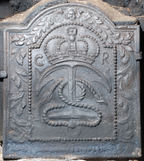
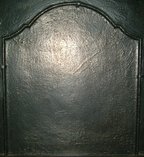
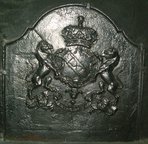
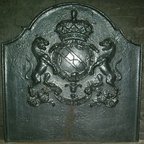
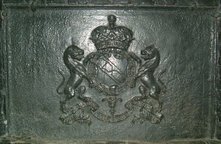
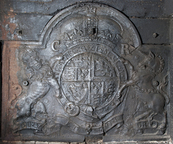
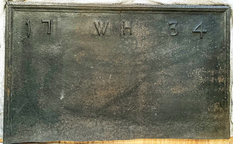
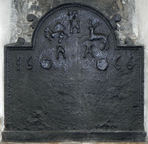

 p139 fig 134.jpg)